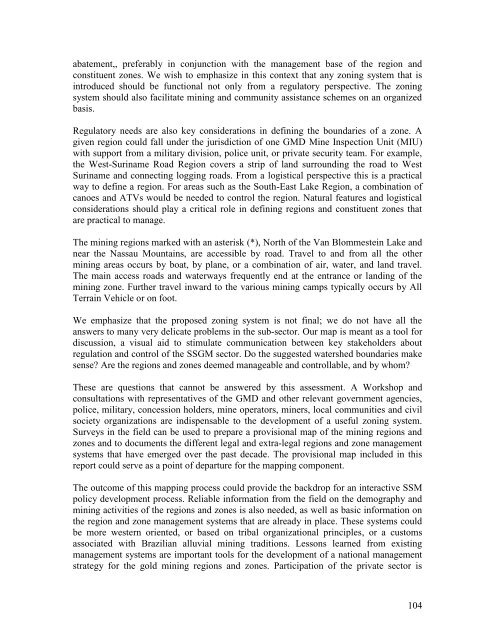SITUATION ANALYSIS OF THE SMALL-SCALE GOLD ... - WWF
SITUATION ANALYSIS OF THE SMALL-SCALE GOLD ... - WWF
SITUATION ANALYSIS OF THE SMALL-SCALE GOLD ... - WWF
You also want an ePaper? Increase the reach of your titles
YUMPU automatically turns print PDFs into web optimized ePapers that Google loves.
abatement,, preferably in conjunction with the management base of the region and<br />
constituent zones. We wish to emphasize in this context that any zoning system that is<br />
introduced should be functional not only from a regulatory perspective. The zoning<br />
system should also facilitate mining and community assistance schemes on an organized<br />
basis.<br />
Regulatory needs are also key considerations in defining the boundaries of a zone. A<br />
given region could fall under the jurisdiction of one GMD Mine Inspection Unit (MIU)<br />
with support from a military division, police unit, or private security team. For example,<br />
the West-Suriname Road Region covers a strip of land surrounding the road to West<br />
Suriname and connecting logging roads. From a logistical perspective this is a practical<br />
way to define a region. For areas such as the South-East Lake Region, a combination of<br />
canoes and ATVs would be needed to control the region. Natural features and logistical<br />
considerations should play a critical role in defining regions and constituent zones that<br />
are practical to manage.<br />
The mining regions marked with an asterisk (*), North of the Van Blommestein Lake and<br />
near the Nassau Mountains, are accessible by road. Travel to and from all the other<br />
mining areas occurs by boat, by plane, or a combination of air, water, and land travel.<br />
The main access roads and waterways frequently end at the entrance or landing of the<br />
mining zone. Further travel inward to the various mining camps typically occurs by All<br />
Terrain Vehicle or on foot.<br />
We emphasize that the proposed zoning system is not final; we do not have all the<br />
answers to many very delicate problems in the sub-sector. Our map is meant as a tool for<br />
discussion, a visual aid to stimulate communication between key stakeholders about<br />
regulation and control of the SSGM sector. Do the suggested watershed boundaries make<br />
sense? Are the regions and zones deemed manageable and controllable, and by whom?<br />
These are questions that cannot be answered by this assessment. A Workshop and<br />
consultations with representatives of the GMD and other relevant government agencies,<br />
police, military, concession holders, mine operators, miners, local communities and civil<br />
society organizations are indispensable to the development of a useful zoning system.<br />
Surveys in the field can be used to prepare a provisional map of the mining regions and<br />
zones and to documents the different legal and extra-legal regions and zone management<br />
systems that have emerged over the past decade. The provisional map included in this<br />
report could serve as a point of departure for the mapping component.<br />
The outcome of this mapping process could provide the backdrop for an interactive SSM<br />
policy development process. Reliable information from the field on the demography and<br />
mining activities of the regions and zones is also needed, as well as basic information on<br />
the region and zone management systems that are already in place. These systems could<br />
be more western oriented, or based on tribal organizational principles, or a customs<br />
associated with Brazilian alluvial mining traditions. Lessons learned from existing<br />
management systems are important tools for the development of a national management<br />
strategy for the gold mining regions and zones. Participation of the private sector is<br />
104
















